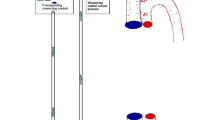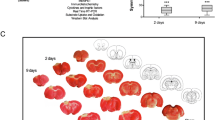Abstract
In the present investigation, regional ATP, glucose, and lactate contents were examined in the cortical and subcortical structures after cold lesion in rats. Bioluminescence imaging of ATP, glucose, and lactate was performed in serial tissue sections at 4 h (n=4), 12 h (n=4) and 24 h (n=4) after cold injury or sham surgery. Bioluminescence images were analyzed by computer-assisted densitometry, at the lesion site, in cortical areas, in the hippocampus, and in the thalamus. ATP and glucose content were significantly decreased at the lesion site as well as on the contralateral side after 4, 12, and 24 h postinjury. Lactate content increased significantly in the hippocampal area on the ipsilateral side at 12 h. Cortical lactate was bilaterally unchanged.
The cold lesion injury led to a characteristic ischemic profile in the hippocampus signaled by low ATP and glucose content paralleled by high lactate levels. The otherwise global depletion of glucose and ATP suggests that other factors besides cerebral blood flow may contribute to the impairment of energy metabolism.
Similar content being viewed by others
References
Azbill R., Mu X., Bruce-Keller A.J., Mattson M.P., and Springer J. (1997) Impaired mitochondrial function, oxidative stress and altered antioxidant enzyme activities following traumatic spinal cord injury. Brain Res. 765, 283–290.
Frei H.J., Wallenfang Th., Pöll Th., Reulen H.J., Schubert R., and Brock M. (1973) Regional cerebral blood flow and regional metabolism in cold induced oedema. Acta Neurochirur. 29, 15–28.
Hovda D.A., Yoshino A., Kawamata T., Katayama Y., and Becker D.P. (1991) Diffuse prolonged depression of cerebral oxidative metabolism following concussive brain injury in the rat: a cytochrome oxidase histochemistry study. Brain Res. 567, 1–10.
Laurer H., Mautes A., Ludt H., Fuchs M., Weinzierl M., Nacimiento A.C., and Nacimiento W. (1996) Topography of breakdown of blood-brain barrier after cortical cold injury in the rat. Soc. Neurosci. Abstr. 22, 743.11.
Mautes A., Schneider G., Müller A., Kramann B., Nacimiento A.C., and Steudel W.I. (1998) Regional relationships between brain energy metabolism, bloodbrain barrier disruption and cellular inflammatory responses following experimental TBI, in Pathophysiological Principles and Controversies in Neurointensive Care Zuckschwerdt Verlag, München, pp. 15–21.
Mautes A.E.M., Schröck H., Nacimiento A.C., and Paschen, W. (2000) Regional spinal cord blood flow and energy metabolism in rats after laminectomy and acute compression injury. Eur. J. Trauma 26, 122–130.
Mautes A., E., M., Thome D., Steudel W.-I., Nacimiento A.C., Yang Y. and Shohami E. (2001) Changes in regional energy metabolism after closed head injury in the rat. J. Mol. Neurosci. 16, 33–39.
Morita-Fujimura Y., Fujimura M., Gasche Y., Copin J.C., and Chan PH. (2000) Overexpression of copper and zinc superoxide dismutase in transgenic mice prevents the induction and activation of matrix metalloproteinases after cold injury-induced brain trauma. J. Cereb. Blood Flow Metab. 20, 130–138.
Pulsinelli W.A. (1992) Pathophysiology of acute ischemic stroke. Lancet 339, 533–539.
Reulen H.J. and Kreysch H.G. (1973) Measurement of brain tissue pressure in cold induced cerebral edema. Acta Neurochir. 29, 29–40.
Schneider G.H. Hennig S., Lanksch W.R., and Unterberg A. (1994) Dynamics of posttraumatic brain swelling following a cryogenic injury in rats. Acta Neurochir. Suppl. (Wien) 60, 437–439.
Schneider G., Mautes A., Laurer H., Wagner D., Kramann B., Steudel W.-I., and Hagen T. (1999) Correlation between cerebral blood volume (CBV), cerebral blood flow (CBF) and energy metabolism after cortical corld lesion in the rat brain. 11th European Congress of Neurosurgery European Association of Neurosurgical Societies (EANS), Monduzzi, Bologna, Italy, pp. 599–605.
Sutton R.L., Hovda D.A., Adelson P.D., Benzel E.C., and Becker D.P. (1994) Metabolic changes following cortical contusion: relationships to edema and morphological changes. Acta Neurochir. 60, 446–448.
Taupin V., Toulmond S., Serrano -A., Benavides -J., and Zavala -F. (1993) Increase in IL-6, IL-1 and TNF levels in rat brain following traumatic lesion. Influence of pre- and post-traumatic treatment with Ro5 4864, a peripheral-type (p site) benzodiazepine ligand. J. Neuroimmunol. 42, 177–185.
Woodroofe M., N., Sarna G., S., Wadhwa M., Hayes G., M., Loughlin A., J., Tinker A., and Cuzner M.L. (1991) Detection of interleukin-1 and interleukin-6 in adult rat brain, following mechanical injury, by in vivo microdialysis: evidence of a role for microglia in cytokine production. J. Neuroimmunol. 33, 227–236.
Yamakami I. and McIntosh, T. (1989) Effects of traumatic brain injury on regional cerebral blood flow in rats as measured with radiolabeled microspheres. J. Cereb. Blood Flow Metab. 9, 117–124.
Yan H.Q., Banos M.A., Herregodts, P., Hooghe R., Hooghe Peters, E.L. (1992) Eur. J. Immunol. 22, 2963–2971.
Yu N., Maciejewski-Lenoir D., Bloom F.E., and Magistretti P.J. (1995) Tumor necrosis factor-alpha and interleukin-1 enhance glucose utilization by astrocytes: involvement of phospholipase A2. Mol. Pharmacol. 48, 550–558.
Author information
Authors and Affiliations
Corresponding author
Rights and permissions
About this article
Cite this article
Weinzierl, M.R., Laurer, H.L., Fuchs, M. et al. Changes in regional energy metabolism after cortical cold lesion in the rat brain. J Mol Neurosci 18, 247–250 (2002). https://doi.org/10.1385/JMN:18:3:247
Issue Date:
DOI: https://doi.org/10.1385/JMN:18:3:247




